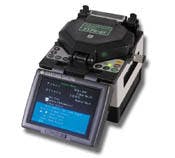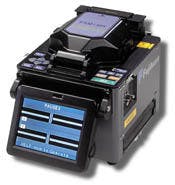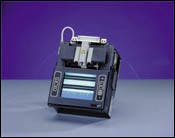As the name implies, fusion splicers (see table, page 66) are instruments that make a fusion splice; that is, at the junction where two or more optical fibers are brought together, the fibers are melted together to form a single strand. Optical-fiber cables are joined in this way for any number of reasons: to shorten long cable runs, to economize in crowded conduits, and to meet fire code restrictions, to name a few. Fusion splicing generally uses an electric arc to soften the ends of the two glass fibers, at high temperature, while they are in contact with each other and are being pushed slightly together. When a fusion splice is properly made, the joint is virtually indistinguishable from an uncut fiber.
Sounds easy? There used to be several intangibles that you had to take into account when splicing two optical fibers together. During the primitive stages of modern fusion splicer development no more than eight years ago, a length of stripped fiber would curl a bit along its length when you placed it in a splicing V-groove. This inconvenience was called "fiber curl." Fiber curl adversely affected mass-fusion splice yield because it contributed to splicer offset. Offset causes core misalignment that results in higher splice losses. Offset can also be caused by contaminants such as dirt in the splicer V-grooves and particles or buffer remains on the bare glass.
You and your fusion splicer had to contend with the sun and wind since this is an outside plant (OSP) activity. At times, when using a V-groove to passively align the two fibers, you had to cope with various types of geometrical aberrations in the fibers themselves. Large diameter fibers rise up from the V-groove, while small fibers sink down. Cladding noncircularity, or "ovality" as it was sometimes called, also made it hard for you to align the fiber cores. The joint's loss will depend on the angular orientation of the oval fiber in the groove. Any noncircular fiber or offset diameter will affect the reliability of your splice.
Technical innovations have helped to erase these primitive concerns. Automation, compatible software, and one-step procedures have taken away the element of chance and the capacity for human error. Today's fusion splicers either use fixed V-groove or core alignment systems. "High-end" single-fiber splicers use the core alignment technology, while mass fusion splicers and "mini" (portable) splicers use fixed V-groove.
Fixed V-groove
The fixed V-groove splicer is an economical choice that depends upon quality fiber for high-quality results. When a fixed V-groove splicer is used to estimate splice loss, it operates by assuming that the cladding of the fibers-not the cores-is aligned. Manufacturers have improved fiber quality in recent years so this is not an issue anymore. George O'Mara, production manager, Sumitomo Electric Lighwave (www.sel-rtp.com), told how "fiber curl" is no longer a problem, even with ribbon fiber. "We are in a fortunate position to have some new technology to manage with the V-groove and to look at our ribbon closely to make sure it is what we need to do the splicing." Sumitomo's Type-65 Micro-Mass fusion splicer uses this fixed V-groove alignment system and features a 5.6-inch display to give you a clear fiber image even in direct sunlight.
The fiber viewing system provides simultaneous focusing of up to 12 fibers at a time and maintains equal resolution across all fibers for improved accuracy of splice loss estimations. Also, the high-speed, high-resolution image processing system automatically evaluates the fibers in two planes (X and Y axis) for cleave end-face quality, cleave length irregularity, and fiber offset to screen out most likely causes in high-loss splices. With battery operation, wind protection, and a compact size, the Type-65 is designed for aerial and taut-sheath applications. This wind protective design lets you splice in winds of up to 30 mph.
Fitel Technologies' (www.fiteltech.com) S199S is an example of how you can splice in the field for longer periods of time without worrying about running out of power. On average, it takes a longer amount of time to splice using fixed V-groove technology as opposed to core-to-core alignment. The S199S has a battery capacity indicator that gives you an indication of how much longer you can operate in the field before you have to recharge. "A slide-in battery in the S199S as well as in Fitel's core-aligning S176 makes the fusion splicers more portable," says Darren Newman, service engineer at Fitel's technical center. Either an AC/DC converter or battery can be slotted in the main body of the S199S without wiring.
Corning Cable Systems' (www.corn ing.cablesystems.com) MiniMASS Series 5000 fixed V-groove fusion splicer offers an uninterruptible power supply. You can either operate on AC, DC, or battery power with the MiniMASS Series 5000. Once either source of power runs out, the other will automatically take its place. "If you are in the process of splicing and the AC power goes, it will not stop the process," explains Jeff Fullwood, product line specialist for splice equipment. "This makes sure there is no 'hiccup' in your performance." Also, a "snap-in" magnetic handler feature is designed for consistent placement into the V-groove. These handlers are made of a high-density polymer material. At the bottom side of the handler, there is a small metal plate. When you place the handler in the stage of the splicer, a magnet pulls the handler and the fiber into the groove. This feature lets you place the fibers to be spliced into the unit without having to physically touch the fibers and risk contamination.
Profile alignment system
A fusion splicer using a profile alignment system images fibers and measures the important geometrical parameters of each cable. By viewing the fibers from two perpendicular directions, the images are computer-processed and analyzed to determine cladding offset, core deformation, variation in fiber outer diameters, and other relevant parameters. These measurements are used in an algorithm to estimate a splice loss.
Alcoa Fujikura Ltd. (www.aflfiber.com) offers an FSM-40S fusion splicer that uses PAS core alignment technology. This type of splicer is designed to optimize the alignment of the fiber before splicing to get the lowest possible splice loss. The FSM-40S features a selectable image display that includes single- and dual-axis fiber viewing on a 5-inch LCD monitor. Instead of evaluating the fiber in two planes (X and Y axis), such as with fixed V-groove technology, PAS measures alignment on three planes (X, Y, and Z axis).
This automated method of fusion splicing requires several moving parts to measure alignment on three planes, and generates a tremendous amount of heat. For this reason, the FSM-40S features automatic temperature and humidity compensation. It can withstand extreme environments and means you can create an accurate core-to-core splice in any OSP project.
"An internal pressure and temperature gauge continuously monitors the atmospheric surroundings around the splicer," explains Vitas Laniauskas, product specialist (OFSP), Alcoa Fujikura Ltd. "In certain situations, the gauge will alert the operator, or will make changes, or 'keep tabs' on changes when an arc calibration takes place." A feature that compensates for environmental conditions makes the FSM-40S a solution for aerial taut-sheath applications. Aerial taut-sheath splicing involves cross winds, and at times, harsh outdoor conditions. Also, the small footprint of the FSM-40S makes the unit portable, and it "won't get in your way" during aerial taut-sheath splicing, according to Laniauskas. This is useful since you work with a limited workspace for this application.
In addition to having a smaller footprint, core-to-core fusion splicers such as the FSM-40S have multiple pre-programmed modes for specialized splicing. Core-to-core fusion splicers are designed to fuse singlemode, multimode, non-zero dispersion-shifted (NZ-DS), dispersion-shifted (DS), cutoff-shifted (CS), and erbium-doped fiber. These different types of fiber will have different dimensions, as well as other individual characteristics such as fiber quality or age.
Local-injection detection alignment
Local-injection detection (LID) alignment is similar to PAS in that it fuses fibers core-to-core and has the ability to splice two fibers with dissimilar characteristics. This technology also aligns the X, Y, and Z axes for a precise splice. In LID alignment, the machine injects light into the core of one fiber and detects the amount of light in the other fiber.
Corning Cable Systems' Series 7000 X77 is an example of a fusion splicer that uses LID alignment. The unit injects a 1,300-nm light signal directly into the core of the fiber, moves the fibers in three axes for alignment purposes, and then monitors that light signal during fusion. An Automatic Fuse Time Control (AFC) feature in the X77 lets you monitor the LID levels in real-time. By actively monitoring the LID levels during fusion, you can compensate for varying environmental changes and splice wear.
Aurora Instruments (www.aurora-instruments.com) offers a Source port option for its FW312 fusion splicer that lets you work with bare or dark-color-coated fibers. This Source port directs the source current away from the standard LID injector to the source port. The feature allows automatic LID-optimized splicing of fibers with any coating or jacket, regardless of thickness or color.
PAS/LID combination
Aurora Instruments Inc. uses a combination of PAS and LID alignment systems in its Fusion 3500. Sub-pixel image processing in both X and Y axes simultaneously lets you get an alignment, slice, and splice loss estimate in addition to giving the operator a clear view of the operation.
When aligning fibers core-to-core, it is important to be able to monitor the splice and check for remaining particles or buffer remains. Data points are normally recognized as pixels on a monitor. Sub-pixel image processing lets you see between pixels. "Sub-pixel resolution is a software method that scans across an image and builds a function of light intensity versus pixel position and it can interpolate between the [data] points," says Larry Wesson, president, Aurora Instruments. This feature lets you view the geometrical parameters of the fibers from two perpendicular directions to use the PAS alignment method. In addition, the ability to measure light intensity complements the LID mode. The sub-pixel resolution will enhance your view of the light so that you may align the cores with improved accuracy.
Looking to the future
Fusion splicer manufacturers are moving towards units with a smaller footprint, more programmable features, automation, versatility, and ruggedness. Improvements in fiber manufacturing are reducing quality concerns, and technology finds new ways to help you.
Ryan Cliche is Assistant Editor for Cabling Installation & Maintenance.
If your company manufactures the type of products in this table, and you wish to be included in future Product Updates, contact Ryan Cliche at tel: (603) 891-9229, or e-mail: [email protected].




